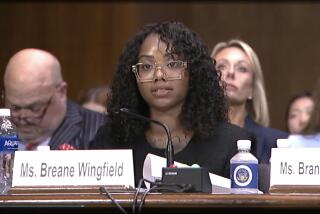For Young Offenders, a Softer Approach
- Share via
SACRAMENTO — Marking a sharp turn in philosophy, the Schwarzenegger administration agreed Monday to put therapy and positive reinforcement at the heart of California’s youth prison system, rejecting today’s more punitive approaches in favor of models that have been successful in other states.
Leaders of the California Youth Authority called the action historic, and said that while the reforms would cost an undetermined amount of money up front, they would save dollars in the long run by helping more young lawbreakers go straight.
Longtime critics agreed, predicting that the new path would put the scandal-plagued agency on a successful course after a 20-year decline.
“This is a commitment to a completely different way of doing business,” said attorney Sue Burrell of the Youth Law Center, which works to improve conditions for young offenders. “This administration deserves a lot of credit for acknowledging that the CYA is a failure and jumping in with both feet to create something better.”
State Sen. Gloria Romero (D-Los Angeles), who at one point proposed closing down the CYA, also was optimistic: “They got the message and I’m ecstatic.”
Romero added that unlike the promises of the past, Monday’s agreement -- outlined in court papers as part of a lawsuit settlement -- has teeth and is enforceable: “This is a dog that will bite,” she said.
Not everyone was praising the new direction. Those who work inside the prisons noted that the Youth Authority houses the toughest 2% of the state’s juvenile offenders, many of whom suffer from mental illness.
“Who wrote this plan, Walt Disney?” scoffed David Darchuk, a prison officer who recently retired after he was stabbed by an inmate at the N.A. Chaderjian Youth Correctional Facility in Stockton. “We’re not talking about bicycle thieves and runaways. These are murderers, carjackers, hard-core criminals. Therapy and coloring crayons aren’t going to help.”
The agreement comes after an extraordinarily turbulent year for the CYA, and after a decade of lawsuits, investigations and legislative scrutiny. Once a national model, the Youth Authority -- with roughly 3,400 inmates, one of the largest juvenile prison systems in the nation -- has become an institution of rampant violence and substandard care.
One statistic sums up its shortcomings most starkly: Three out of four parolees are arrested on new charges within three years of release.
In November, Gov. Arnold Schwarzenegger conceded that the CYA was failing both juvenile offenders and taxpayers, and he agreed to a lawsuit settlement mandating a host of improvements.
But that agreement, while important, failed to spell out any broad shift in mission or long-term vision for the agency. Monday’s order -- signed by lawyers for the state and juvenile advocates and filed in Alameda County Superior Court -- goes much further.
“This is not just about fixing a terrible system so that it’s legally acceptable,” said Sara Norman of the Prison Law Office, the nonprofit firm that filed the lawsuit. “It’s about creating a whole new therapeutic model that is good for kids and good for the society they’re returning to.”
Leaders of the California Correctional Peace Officers Assn., the union representing many employees within the CYA, were skeptical. They argued that what works in other states may not work in California, where extensive gang allegiances make managing inmates more challenging.
“This is a farce,” said Lance Corcoran, executive vice president of the union. Corrections Secretary “Rod Hickman and his agents are experimenting with the lives of staff -- and inmates.”
With eight prisons and three camps, the CYA was created in 1941 after reformers argued that teenagers did not belong in lockups that also housed hardened adult criminals. For decades, the agency prided itself on a paternalistic, compassionate approach to managing delinquent kids.
In recent years, however, the Youth Authority has become dominated by a more violent cadre of convicts, ages 14 to 25. And while its statutory mission calls for a focus on rehabilitation, the agency has gradually employed more prison-like methods, critics say, such as extensive isolation of the most unruly youths.
The lawsuit, first filed in 2002, was a taxpayer action alleging, in essence, that the CYA was improperly spending state funds on unlawful practices.
Over the last year, its troubles have been dramatically exposed on several fronts, beginning with the suicides last January of two teenagers in an isolation cell at the CYA prison in Ione, east of Sacramento.
Deon Whitfield, 17, of Los Angeles and Durrell Taddon Feaster, 18, of Stockton hanged themselves with bedsheets. In the last five years, there have been seven suicides and hundreds of attempted suicides in the juvenile system.
That incident was followed by the release of a videotape, broadcast nationwide, showing two correctional counselors at another prison kicking and striking two young inmates as they lay face-down on the floor.
Other episodes included an outcry over the use of metal cages to confine youths who were considered a threat, and the release of expert reports that detailed problems with medical care, mental health treatment and the use of force by staff.
In response, CYA leaders have made several changes. They ended the use of the cages for most purposes; closed a notorious, decrepit housing unit at the Ione prison; and fired the employees involved in the videotaped beatings.
More recently, administration officials have toured youth prison systems in Missouri, Texas and other states, looking for ideas. Missouri’s model, which relies on small living units, a strong peer counseling system and intensive therapy, has been particularly successful, becoming a national model.
CYA officials said the blueprint for California most probably would tap elements found in several states, as well as the knowledge of a consultant to be hired by March 1 to guide the transition. Under the agreement, a final decision on a model is due Nov. 1.
Certain features already are spelled out in the court documents. The CYA must:
* Shift to an “open programming” model, as opposed to one that confines inmates in their cells for long stretches at a time, at all prisons by May 2. Under the change, inmates must be released for education, meals, treatment and recreation on a daily basis, and dangerous youths would be separated from those considered vulnerable.
* House youths in the facility closest to their homes. This addresses a chief complaint of families, who often live hundreds of miles from their incarcerated children, making visits difficult.
* Involve families in the therapy provided to youths, unless it would be considered detrimental to the inmate.
* Emphasize “positive reinforcement rather than punitive disciplinary methods” to encourage good behavior.
* Require all staff who work with youths to be trained in rehabilitative and treatment services.
One item not specified -- and considered crucial by advocates for inmates -- is the size of living units. Researchers agree that a smaller setting, allowing for greater staff interaction and familiarity with youths, can deliver great rehabilitative benefits.
With Monday’s agreement, Schwarzenegger is continuing on a course he set last month with a proposed reorganization of adult corrections. That plan, which must be approved by the Legislature, also emphasizes rehabilitation as an essential ingredient in preparing parolees for their return to the community.
Among those cheering on the sidelines is Allen Feaster, whose son committed suicide a little more than a year ago. Feaster, who has since become a champion for reform of the CYA, says he’s optimistic.
“If this type of program had been in place before, my son would be alive today,” he said Monday. “These are good words on paper. Let’s hope 2005 is the year for change.”
More to Read
Get the L.A. Times Politics newsletter
Deeply reported insights into legislation, politics and policy from Sacramento, Washington and beyond. In your inbox twice per week.
You may occasionally receive promotional content from the Los Angeles Times.










